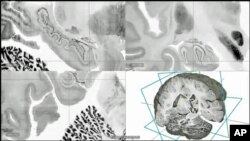Brain imaging, once thought to be too expensive for widespread use in the developing world, may soon be available in low-income countries. The technology, which visualizes brain activity using infrared light, can identify the first signs of cognitive delays in newborns and young children who could be experiencing the effects of malnutrition.
Functional near-infrared spectroscopy, or fNIRS, involves placing a tiny, soft helmet around an infant's head. An invisible beam of infrared light, the same as the light emitted by a TV remote control, is sent through the skull, helping to determine whether the baby is cognitively on track for his or her age.
fNIRS is considered safer than other imaging modalities, including MRI or PET scan. It is also portable. The brain scanner can be loaded into a vehicle and driven from village to village by health care personnel.
Clare Elwell, a professor of Medical Physics at University College London, helped develop the relatively low-cost, non-invasive optical imaging technology.
She says the device, which has been used for years to identify delays in British infants, measures the amount of oxygen in the blood to see how babies’ brains are developing.
“And as you use different regions of your brain, you direct oxygen to those different brain regions. And so if we look at the change in the distribution of the oxygen in your brain, we can work out how active your brain is and what your brain is actually processing," said Elwell.
In a study field-testing the equipment in rural Gambia, Elwell says babies between four and eight months old were studied three times over the course of 15 months. Researchers noted the infants' responses to different images and sounds.
“So if we present the babies with visual or auditory stimuli, then we expect certain brain regions to light up essentially. We expect the oxygen to be diverted to certain brain regions. And that tells us that those brain regions are mature and they are functioning normally. And therefore that gives us a mark that that child’s brain is developing normally," she said.
The infants were shown pictures of objects and people, such as full-color, life-size images of adults who moved their eyes, and a video of an adult playing "peek-a-boo." The visual stimuli also included images of toys and a horse. The babies' auditory center was tested with the sound of human speech and familiar but non-human sounds such as rattles, running water and bells. Their brain recognition patterns were compared to those of British children.
An article describing the results of the Gambian trials of fNIRS was published in Nature Scientific Reports.
“Nobody has ever done this in infants who are at risk in these resource-poor or low income settings. And, of course, some of the infants we are studying in Africa are particularly at risk, for example, for malnutrition or childhood diseases that they might not encounter in other settings,' she said.
Clare Elwell says the goal is to identify those infants so they can receive proper nutrients or be treated for diseases that impair brain development.
Functional near-infrared spectroscopy, or fNIRS, involves placing a tiny, soft helmet around an infant's head. An invisible beam of infrared light, the same as the light emitted by a TV remote control, is sent through the skull, helping to determine whether the baby is cognitively on track for his or her age.
fNIRS is considered safer than other imaging modalities, including MRI or PET scan. It is also portable. The brain scanner can be loaded into a vehicle and driven from village to village by health care personnel.
Clare Elwell, a professor of Medical Physics at University College London, helped develop the relatively low-cost, non-invasive optical imaging technology.
She says the device, which has been used for years to identify delays in British infants, measures the amount of oxygen in the blood to see how babies’ brains are developing.
“And as you use different regions of your brain, you direct oxygen to those different brain regions. And so if we look at the change in the distribution of the oxygen in your brain, we can work out how active your brain is and what your brain is actually processing," said Elwell.
In a study field-testing the equipment in rural Gambia, Elwell says babies between four and eight months old were studied three times over the course of 15 months. Researchers noted the infants' responses to different images and sounds.
“So if we present the babies with visual or auditory stimuli, then we expect certain brain regions to light up essentially. We expect the oxygen to be diverted to certain brain regions. And that tells us that those brain regions are mature and they are functioning normally. And therefore that gives us a mark that that child’s brain is developing normally," she said.
The infants were shown pictures of objects and people, such as full-color, life-size images of adults who moved their eyes, and a video of an adult playing "peek-a-boo." The visual stimuli also included images of toys and a horse. The babies' auditory center was tested with the sound of human speech and familiar but non-human sounds such as rattles, running water and bells. Their brain recognition patterns were compared to those of British children.
An article describing the results of the Gambian trials of fNIRS was published in Nature Scientific Reports.
“Nobody has ever done this in infants who are at risk in these resource-poor or low income settings. And, of course, some of the infants we are studying in Africa are particularly at risk, for example, for malnutrition or childhood diseases that they might not encounter in other settings,' she said.
Clare Elwell says the goal is to identify those infants so they can receive proper nutrients or be treated for diseases that impair brain development.







